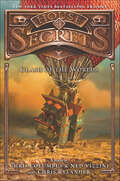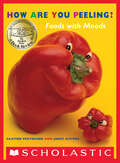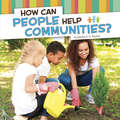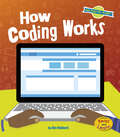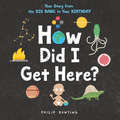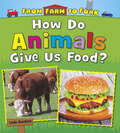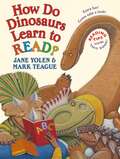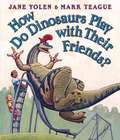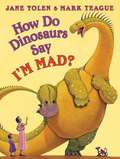- Table View
- List View
House Sparrows (Backyard Birds Ser.)
by Lisa J. AmstutzWho’s that singing in the backyard? It’s a house sparrow! Find out where house sparrows live, what they eat, and how to identify the birds and their eggs.
House of Secrets: Battle of the Beasts (House of Secrets Series #2)
by Ned Vizzini Chris ColumbusThe sequel to the New York Times bestselling House of Secrets—hailed by J. K. Rowling as "a breakneck, jam-packed roller coaster of an adventure"—this second installment by Hollywood director Chris Columbus (of Harry Potter fame) and bestselling author Ned Vizzini (It's Kind of a Funny Story) is full of even more explosive twists and turns.Since the siblings' last adventure, life in the Walker household is much improved—the family is rich and the Wind Witch is banished. But no Walker will be safe until she is found. Summoning her to San Francisco brings all the danger that comes with her, and puts the Walkers in the crosshairs of a mysterious journey through Denver Kristoff's books. As the Walkers travel from ancient Rome to World War II to Tibet, they are tested in ways that cut deeper than before—by Denver Kristoff, the Wind Witch, and one another.Fantasy fiction fans who enjoy Rick Riordan will find much to love in this thrilling and action-packed novel.
House of Secrets: Clash of the Worlds (House of Secrets Series #3)
by Ned Vizzini Chris Rylander Chris ColumbusThe final book in the New York Times bestselling House of Secrets series that was called “a breakneck, jam-packed roller coaster of an adventure” by J. K. Rowling. Created by Hollywood director Chris Columbus (of Harry Potter fame) and bestselling author Ned Vizzini (It’s Kind of a Funny Story), with the acclaimed author of the Codename Zero series and the Fourth Stall saga, Chris Rylander.With their last adventure just barely over, the Walker kids thought life would finally go back to normal. But things don’t remain calm for long . . . especially when the colossus Fat Jagger turns up in San Francisco Bay—and he’s in danger!With the police closing in, the Walkers must figure out how to save their giant friend. When a frost beast is spotted in Santa Rosa—and more mystical creatures start appearing all over America—it’s soon clear that the characters from Denver Kristoff’s works are invading the real world. It’s up to Brendan, Eleanor, and Cordelia to reenter the book world one last time to keep the worlds from colliding, causing mass destruction.They will have to track down three Worldkeepers hidden in Kristoff’s books—magical items that when used together will seal the worlds off for good. But the Walkers’ first move leads them straight into the Wild West, with lethal outlaws and lawless deputies—and that’s just the beginning. They’ll encounter dinosaurs, aliens, killer robots, and the Wind Witch herself—with new friends and old—and be faced with some of the deadliest choices they’ll ever have to make. The scariest thing of all could be deciding who to trust, since everyone is hiding something. . . .
How Animal Babies Stay Safe (Let's-Read-and-Find-Out Science 1)
by Mary Ann FraserRead and find out about how animal parents keep their babies safe from predators in this colorfully illustrated nonfiction picture book.This is a clear and appealing science book for early elementary age kids, both at home and in the classroom. It looks at the many strategies animal babies use to survive in a dangerous world. Some babies hide in nests or dens, some ride on thier parents' back or in their pouches, some use camouflage, and some rely on their parents' sharp claws and teeth to fend off enemies. Whether showing "a mother monkey swinging through the jungle with her baby on her back or two baby raccoons peeking out of their tree-house home while their mother lures a bobcat away from her young," wrote Kirkus, this book captures the eternal appeal of baby animals.It's a Level 1 Let's-Read-and-Find-Out, which means the book explores introductory concepts perfect for children in the primary grades. The 100+ titles in this leading nonfiction series are:hands-on and visualacclaimed and trustedgreat for classroomsTop 10 reasons to love LRFOs:Entertain and educate at the same timeHave appealing, child-centered topicsDevelopmentally appropriate for emerging readersFocused; answering questions instead of using survey approachEmploy engaging picture book quality illustrationsUse simple charts and graphics to improve visual literacy skillsFeature hands-on activities to engage young scientistsMeet national science education standardsWritten/illustrated by award-winning authors/illustrators & vetted by an expert in the fieldOver 130 titles in print, meeting a wide range of kids' scientific interestsBooks in this series support the Common Core Learning Standards, Next Generation Science Standards, and the Science, Technology, Engineering, and Math (STEM) standards. Let's-Read-and-Find-Out is the winner of the American Association for the Advancement of Science/Subaru Science Books & Films Prize for Outstanding Science Series.
How Are You Peeling? (Scholastic Bookshelf)
by Saxton Freymann Joost ElffersLet Scholastic Bookshelf be your guide through the whole range of your child's experiences-laugh with them, learn with them, read with them! Eight classic, best-selling titles are available now!Category: Feelings"Amused? Confused? Frustrated? Surprised? Try these feelings on for size."This is a book that asks all the right questions. And leaves you feeling great no matter what the answers are!"Who'd have dreamed that produce could be so expressive, so charming, so lively and so funny?...Freymann and...Elffers have created sweet and feisty little beings with feelings, passions, fears and an emotional range that is, well, organic."-The New York Times Book Review
How Are You, Verity?
by Meghan Wilson DuffA neurodivergent child interacts with their neighbors to discover the true meaning behind greetings and salutations. When people say &“How are you?&” are they really asking or just saying hello? Verity, who is neurodivergent, plans an experiment to figure this out. Verity is bubbling with excitement about an upcoming school field trip to the aquarium! When neighbors ask, &“How are you?&” Verity shares their excitement and fascinating facts about sea animals. Their older brother John kindly suggests that the question "How are you?" is actually a greeting and not an invitation to share so much. Verity plans an experiment to find out if their brother is right. But when the trip to the aquarium is cancelled, Verity is heartbroken. When people ask &“How are you?&” what should they say then?
How Big Could Your Pumpkin Grow?
by Wendell MinorEvery year, giant pumpkin contests take place at fairs across the country—the 2012 record-holder weighed over a ton! The latest craze is to carve the most enormous pumpkins into racing boats. But what&’s next? Why not think really big? Award-winning artist Wendell Minor does just that as he imagines larger-than-life pumpkins decorating some of America&’s favorite places—as immense as the Capitol dome, Mount Rushmore, the Brooklyn Bridge, even the Grand Canyon! This celebration of famous landmarks and landscapes plays with concepts of size and scale and is full of fun facts.
How Birds Sleep
by David ObuchowskiDiscover the mysterious and fascinating sleeping habits of more than twenty bird species from around the world in this gorgeously illustrated read-aloud picture book, perfect for bedtime, or any time.Have you ever seen a bird sleep? Or wondered just when it is that migrating cranes find the time to catch Z&’s as they cross the ocean? From the parrots of Thailand to the ostriches of Australia and even the pigeons of New York City, every bird sleeps—but they do it in ways that will surprise and delight you. Some hang from tree branches, others doze while gliding, and some even burrow underground for a nap. Written in a witty, conversational voice, and with gorgeous illustrations, this picture book is bursting with interesting facts about this underexplored aspect of bird life all around us.
How Books Are Made
by Martha E. H. RustadTo make a book, you first start with an idea. What comes next? Crack open the cover to find out how books are made.
How Can People Help Communities? (Community Questions)
by Martha E. RustadA community is only as strong as its individual members. What roles do those members play, and how do citizens work together to complete common tasks and achieve goals? A clear question-answer format, paired with photos kids can relate to, shows the importance of responsibility and cooperation. A simple activity encourages young readers to actively participate in their own community.
How Carrot and Cookie Saved Christmas
by Erica S. PerlA festive pun-filled story perfect for the holidays!In this follow-up to When Carrot Met Cookie, Christmas is fast approaching, and Carrot and Cookie are both worried—they can't find the right present for each other! But when they hear a crash on Christmas Eve and find a sick Santa too ill to keep flying his sleigh, they know there are more important matters at hand. Can these friends conjure up enough Christmas magic to step into Santa's shoes, deliver the presents themselves, and save the day? Hilarious and heartwarming, this is the perfect gift for future foodies or anyone looking for some special holiday cheer.
How Coding Works (Our Digital Planet Ser.)
by Ben HubbardThis book takes the mystery out of computer programming. Learn about coding, algorithms and more.
How Computers Work (Our Digital Planet Ser.)
by Ben HubbardEver wonder what goes on inside your computer? Take a look into how processors, networks, and more are all connected.
How Could a Bear Sleep Here?
by Julie GonzalezIt's time for Shelby to hibernate, but how could a bear sleep in this noisy forest?The woodpeckers are rat-tat-tatting, the squirrels are cracka-cracka-crunching--there's too much noise! When Shelby spies the perfect cave, only too late does he realize he's hopped aboard a tour bus bound for the beach.Coupled with hysterically expressive illustrations by Stephanie Laberis, Julie Gonzalez's lively text and familiar refrain sings as Shelby, after several attempts to snooze in the tropics with increasing exhaustion, finally discovers the perfect solution to his noise problem. This is a great read-aloud for young readers who will recognize the refrain ("How could a bear sleep here?") and the silliness of Shelby's predicament
How Deep Is Your Love: A Children's Picture Book
by Bee GeesA majestic picture book based on the Bee Gees's classic love song "How deep is your love? I really mean to learn 'Cause we're living in a world of fools Breaking us down When they all should let us be We belong to you and me . . ." How Deep Is Your Love is a fantastical picture book based on one of the Bee Gees's biggest hits. The song topped the Billboard Hot 100 chart, remaining in the top ten for seventeen weeks, and won the band's first of eight GRAMMY awards. With lyrics by the Bee Gees and illustrations by J.L. Meyer, the picture book tells the tale of two bunny mermaids who meet on a rock and descend into the water together. As the bunnies escape traps, skirt around nets and hooks, and protect each other in this thrilling adventure, they realize how deep their love is. Meyer's imaginative story compliments the hit song perfectly and will delight children and adults alike.
How Deep Is the Ocean? (Let's-Read-and-Find-Out Science 2)
by Kathleen Weidner ZoehfeldRead and find out about the deepest part of the ocean in this colorfully illustrated nonfiction picture book.The ocean covers almost three-quarters of the Earth, but how deep does it go? Put on your scuba gear and explore the ocean, from its shallowest waters to its deepest, most mysterious parts. As you dive deeper, you’ll discover glowing animals, strange creatures that don’t need sunlight to survive, and even the largest hunter in the world.With beautiful illustrations and engaging text, How Deep Is the Ocean? will guide young readers into the deepest parts of the ocean. Featuring a find-out-more section with a water-pressure experiment, a lesson in making a sounding line to learn how scientists measure the depth of the ocean, a glossary of new terms, and web research prompts, this book will begin children’s explorations of the deep sea. Both the text and the artwork were vetted for accuracy by Dr. David Gruber, real-life deep sea explorer and professor of biology and environmental science at Baruch College.This is a clear and appealing science book for early elementary age kids, both at home and in the classroom. It's a Level 2 Let's-Read-and-Find-Out, which means the book explores more challenging concepts for children in the primary grades. The 100+ titles in this leading nonfiction series are:hands-on and visualacclaimed and trustedgreat for classroomsTop 10 reasons to love LRFOs:Entertain and educate at the same timeHave appealing, child-centered topicsDevelopmentally appropriate for emerging readersFocused; answering questions instead of using survey approachEmploy engaging picture book quality illustrationsUse simple charts and graphics to improve visual literacy skillsFeature hands-on activities to engage young scientistsMeet national science education standardsWritten/illustrated by award-winning authors/illustrators & vetted by an expert in the fieldOver 130 titles in print, meeting a wide range of kids' scientific interestsBooks in this series support the Common Core Learning Standards, Next Generation Science Standards, and the Science, Technology, Engineering, and Math (STEM) standards. Let's-Read-and-Find-Out is the winner of the American Association for the Advancement of Science/Subaru Science Books & Films Prize for Outstanding Science Series.
How Did Humans Go Extinct?
by Paul Hoppe Johnny MarcianoLet’s learn about the most mystifying species to ever walk the Earth!“A clever . . . way to bring awareness to the very real threats to humanity posed by war, climate change, and capitalism. A compelling and unique dystopian sci-fi picture book for early school age readers, this is recommended for all collections.” —School Library JournalPlib is like every other Nøørfbløøk kid on Earth, except for one thing.He loves humans—those horrible, terrifying monsters who dominated the planet ten million years ago.Only one thing about the humans bothers Plib. What happened to them all? Did they turn the planet into an uninhabitable wasteland? Or did they turn on each other? Or did the humans die out because of something else they did—or didn’t—do?Find the answer in How Did Humans Go Extinct?
How Did I Get Here?: Your Story from the Big Bang to Your Birthday
by Philip BuntingFrom the Big Bang to your birthday, and (almost) everything in between, this funny and informative book tells your story.You are one of the newest members of a family tree that goes way, way, way back to the very first life on Earth. A lot of incredible things had to happen between the beginning of the universe and today in order to make you. The fact that you (and everyone you know) are here is nothing short of mind-boggling! Read this book to discover how it happened, and prepare to be amazed by the awesomeness of you.This clever, funny, and scientific timeline of the journey of human existence is designed to get young readers asking questions, finding answers, and marveling at the many wonders of our world, from the Big Bang, to evolution, to a brand-new baby, and more.
How Did That Get in My Lunchbox? The Story of Food
by Chris ButterworthFresh retro artwork lures little readers on a tasty trip to farms, dairies, and more. Yum! The best part of a young child's day is often opening a lunchbox and diving in. But how did all that delicious food get there? Who made the bread for the sandwich? What about the cheese inside? Who plucked the fruit? And where did the chocolate in that cookie get its start? From planting wheat to mixing flour into dough, climbing trees to machine-squeezing fruit, picking cocoa pods to stirring a vat of melted bliss, here is a clear, engaging look at the steps involved in producing some common foods. Healthy tips and a peek at basic food groups complete the menu.
How Did Whales Get So Big?: & Other Curious Questions about Animals, Nature, Geology, and Planet Earth (MinuteEarth Explains)
by MinuteEarthSTEM for Kids ― Fun for Kids (Ages 8-10)#1 New Release in Children's Books: Environment & Ecology, Atlases, Anatomy, and Earthquake & VolcanoIn their debut illustrated science book for kids, the team behind the popular YouTube channel MinuteEarth answers all of your child’s wackiest questions about animals, nature, and science alongside engaging images of the natural world.From the scientists, writers, and illustrators at MinuteEarth. Have you ever wondered where Earth’s water came from? Or why leaves change color in the fall? Entertain and educate your kids with fun facts about animals, nature and the wonders of the earth.Amazing STEM for kids, explained simply. With over 300 million views, MinuteEarth simplifies such serious subjects as geology, ecology and biology making them fun for kids. Featuring their signature puns and fun illustrations, this first book in the MinuteEarth Explains series explores topics ranging from weird animal facts to extreme weather, making science for kids enjoyable and unforgettable.Curious questions about our awesome planet. Whether your child is obsessed with the wonder of nature, can’t learn enough interesting facts about animals, or is fascinated by volcanoes, MinuteEarth Explains captures their imagination and fosters an interest in animals, the Earth, and ocean life! By combining humor with rigorous research, this book provides fun facts about animals, nature, science and more in an equally engaging and informative way for kids.MinuteEarth Explains captivates kids with answers to:Why do some animals get gigantic?Why do rivers curve?Can plants talk?How much food is there on earth?And more!If you’re looking for nature books for kids (8-10) or earth science books for kids―or if your child loves books such as The Big Book of Birds, Why?: 1,111 Answers to Everything, or The Wondrous Workings of Planet Earth―then your whole family will love this debut book by MinuteEarth!
How Do Animals Give Us Food? (From Farm To Fork: Where Does My Food Come From? Ser.)
by Linda StanifordThis fascinating book looks at how animals give us food, taking the beef we eat as an example. Engaging text and beautiful, color illustration show readers how beef is produced, processed, and packed through its long journey to end up on our plates.
How Do Dinosaurs Go to School? (Elementary Core Reading Ser.)
by Jane Yolen Mark TeagueNIMAC-sourced textbook <P><P>School has never been so much fun! Come along for a very unusual day and laugh out loud as the dinosaurs enjoy story time, show-and-tell and recess.
How Do Dinosaurs Learn to Read
by Jane YolenAmerica's favorite dinosaurs romp and roar as they soak books in the bathtub, throw them, and finally learn how to carefully read them... with Mama and Papa at bedtime. Get ready to laugh at this lighthearted, heartwarming, and funny approach to books! Children sometimes feel the task of learning to read is overwhelming, but the winning combination of rhyme and illustrations here provide a perfect way to present the subject in a comical, engaging, and nonjudgmental way. The contrast of enormous dinosaurs in kid-sized bedrooms (with human parents) adds irresistible humor as families explore the do's and don'ts of reading. Both practical and engaging, this book shows dinosaurs getting into all sorts of reading-related trouble! But of course, in the end, the dinosaurs learn how to carefully handle their books, read out loud, and read a lot!
How Do Dinosaurs Play with Their Friends?
by Jane Yolen Mark TeagueCome along for some BIG fun as your favorite dinosaurs delight young readers with their playful antics.
How Do Dinosaurs Say Im Mad
by Jane YolenSome of them count to ten, some of them have a time out, and some of them take deep breaths. Then, when the dinosaurs are calm again, they clean up any mess they've made, they say, "I'm sorry," and they give big hugs. Just as you do.


